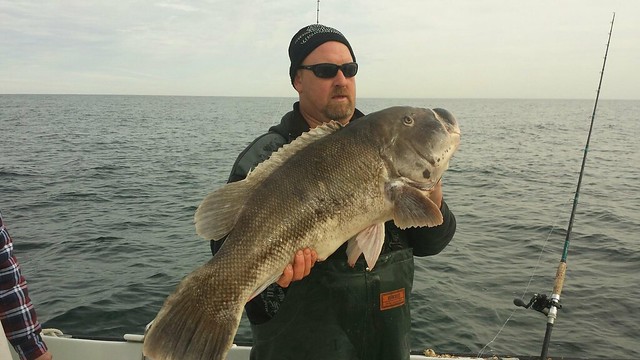Sporting Life

Tog: The Wintertime Wonders
By Dennis Doyle
My almost numb fingers registered just the slightest twitch at the end of my line and I tensed. At the next tic I reflexively slammed back in a hearty strike. Rewarded by an immediate and alarming bend in my rod, I put my shoulder into resisting the effort. The drag was set at max and the reel refused to give up line as my stout, graphite casting rod creaked in protest and arced over the gunnel.
The tug of war lasted probably a long 10 seconds as the beast below insisted on retreating into its rocky hideout below and I insisted, oh no, you don’t. Eventually the stubborn fish changed direction and headed down current, parallel to the rocks, hoping for another exit route.
I cranked the reel’s handle, pumped the rod, and tried to gain some line—no joy there, so the see-saw stalemate continued. The fish turned again and I picked up a few feet, then somehow, using the shift in direction to its advantage, the brute took back all that line plus a few feet. I was amazed at its strength and determination.
This was my first tautog and I was impressed with its performance. I’d been warned it would pull hard but this display of resistance was over the top, especially when I finally got it to the net. Though it was a keeper of 19 inches (16-inch minimum), it was a lot smaller than I thought it would be.
This time of year, tog fishing should definitely be considered as the silver lining to winter weather. The frigid temps will bring the bigger tautog, which are normally found farther out in the Atlantic, closer to shore. Though freezing weather may be generally dispiriting for an angler, already this winter we’ve had a number of warm spells where the temps go up into the 50s for three days or more. When days like that are in the forecast, that’s the time to pull out your heavy rods and head for the salt coast to tangle with some tog.
The tautog is a muscular fish, dark green with thick skin, a tough mouth, and heavy, shell-crushing teeth. Tautog are slow-growing fish and the average size taken is 3 to 5 pounds. You’ll need a stout hook to tangle with the brawlers, they’ll often break or bite right through anything made of thin wire. And you’ll need a better quality, heavy duty spin reel, at least a 3000 series, though baitcasting or conventional gear is by far preferred. The drags and cranking strengths of revolving spool reels are superior and generally stronger and the ability to easily free spool makes depth control far easier. My personal favorite for in-shore fishing is the 5000 series Abu baitcasters with upgraded drag washers and handles.
Once you’ve hooked up with a tog you have mere seconds to get it away from its lair. If it retreats into a hole in the rocks or a cavity of the structure it’s cruising, you likely will not get it back out.
I spool my reel with 40- to 50-pound Power Pro, and the same in fluorocarbon leaders, not just for the pull of the fish, but to resist the abrasion of the areas the blackfish love to hang out. They’re ambush predators and prefer to loiter in and near wrecks, rocks and barnacle encrusted submerged structures that provide concealment and protection.
Ocean City has a good tautog (aka blackfish) population, even for shoreline anglers, plus they have a head boat fishery that focuses on the tasty rascals this time of year. Keep in mind, the world record tog of 28.8 pounds was caught off OC in January 2015.
Togs can be tempted with shrimp, hard crab, sand fleas, clams and scented soft plastics like the Berkley Gulp series presented on bait rigs or jig heads heavy enough to get down to where the fish hang out. They are known bait thieves and have a delicate bite quite unlike any similar size denizens so beware. And bring lots of rigs. If you’re not hanging up and losing them on the rocks and wrecks, your baits are not in the right place.
*****
Fishfinder: The Atlantic oceanside bite is just starting up with a few legal tautog being iced from the headboats heading out from Ocean City in decent weather but it should start getting much better soon. Surfside, the kingfish are now showing up taking bloodworms and there’s a few flounder being caught. Rumors of major sized stripers making their way down from New Jersey are whetting more than a few appetites and nighttime surf fishing in the hopes of getting one of these brutes may pick up at any time.
